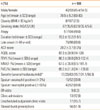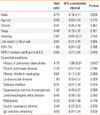1. Jones SC, Iverson D, Burns P, Evers U, Caputi P, Morgan S. Asthma and ageing: an end user's perspective--the perception and problems with the management of asthma in the elderly. Clin Exp Allergy. 2011. 41:471–481.
2. Stupka E, deShazo R. Asthma in seniors: Part 1. Evidence for underdiagnosis, undertreatment, and increasing morbidity and mortality. Am J Med. 2009. 122:6–11.
3. Kim YK, Kim SH, Tak YJ, Jee YK, Lee BJ, Park HW, Jung JW, Bahn JW, Chang YS, Choi DC, Chang SI, Min KU, Kim YY, Cho SH. High prevalence of current asthma and active smoking effect among the elderly. Clin Exp Allergy. 2002. 32:1706–1712.
4. Bellia V, Pedone C, Catalano F, Zito A, Davì E, Palange S, Forastiere F, Incalzi RA. Asthma in the elderly: mortality rate and associated risk factors for mortality. Chest. 2007. 132:1175–1182.
5. Krcmarik JP, Kain KP. Diagnosis and treatment of asthma in elderly patients. AARC Times. 2007. 31:38–40.
6. Reed CE. Asthma in the elderly: diagnosis and management. J Allergy Clin Immunol. 2010. 126:681–687. quiz 8-9.
7. Lee KH, Chin NK, Lim TK. Asthma in the elderly--a more severe disease. Singapore Med J. 2000. 41:579–581.
8. Quadrelli SA, Roncoroni A. Features of asthma in the elderly. J Asthma. 2001. 38:377–389.
9. Gershon AS, Wang C, Guan J, To T. Burden of comorbidity in individuals with asthma. Thorax. 2010. 65:612–618.
10. Parameswaran K, Hildreth AJ, Taylor IK, Keaney NP, Bansal SK. Predictors of asthma severity in the elderly: results of a community survey in Northeast England. J Asthma. 1999. 36:613–618.
11. Peters SP, Jones CA, Haselkorn T, Mink DR, Valacer DJ, Weiss ST. Real-world Evaluation of Asthma Control and Treatment (REACT): findings from a national Web-based survey. J Allergy Clin Immunol. 2007. 119:1454–1461.
12. Cazzoletti L, Marcon A, Janson C, Corsico A, Jarvis D, Pin I, Accordini S, Almar E, Bugiani M, Carolei A, Cerveri I, Duran-Tauleria E, Gislason D, Gulsvik A, Jõgi R, Marinoni A, Martínez-Moratalla J, Vermeire P, de Marco R. Therapy and Health Economics Group of the European Community Respiratory Health Survey. Asthma control in Europe: a real-world evaluation based on an international population-based study. J Allergy Clin Immunol. 2007. 120:1360–1367.
13. Kwon HS, Lee SH, Yang MS, Lee SM, Kim SH, Kim DI, Sohn SW, Park CH, Park HW, Kim SS, Cho SH, Min KU, Kim YY, Chang YS. Correlation between the Korean version of Asthma Control Test and health-related quality of life in adult asthmatics. J Korean Med Sci. 2008. 23:621–627.
14. Thomas M, Kay S, Pike J, Williams A, Rosenzweig JR, Hillyer EV, Price D. The Asthma Control Test (ACT) as a predictor of GINA guideline-defined asthma control: analysis of a multinational cross-sectional survey. Prim Care Respir J. 2009. 18:41–49.
15. Park HS, Kim HY, Nahm DH, Son JW, Kim YY. Specific IgG, but not specific IgE, antibodies to toluene diisocyanate-human serum albumin conjugate are associated with toluene diisocyanate bronchoprovocation test results. J Allergy Clin Immunol. 1999. 104:847–851.
16. American Thoracic Society. Standardization of spirometry, 1994 update. Am J Respir Crit Care Med. 1995. 152:1107–1136.
17. Park H, Jung K, Kim H, Nahm D, Kang K. Neutrophil activation following TDI bronchial challenges to the airway secretion from subjects with TDI-induced asthma. Clin Exp Allergy. 1999. 29:1395–1401.
18. Nair P, Pizzichini MM, Kjarsgaard M, Inman MD, Efthimiadis A, Pizzichini E, Hargreave FE, O'Byrne PM. Mepolizumab for prednisone-dependent asthma with sputum eosinophilia. N Engl J Med. 2009. 360:985–993.
19. Sukkar MB, Wood LG, Tooze M, Simpson JL, McDonald VM, Gibson PG, Wark PA. Soluble RAGE is deficient in neutrophilic asthma and COPD. Eur Respir J. 2012. 39:721–729.
20. Stern L, Berman J, Lumry W, Katz L, Wang L, Rosenblatt L, Doyle JJ. Medication compliance and disease exacerbation in patients with asthma: a retrospective study of managed care data. Ann Allergy Asthma Immunol. 2006. 97:402–408.
21. Nathan RA, Sorkness CA, Kosinski M, Schatz M, Li JT, Marcus P, Murray JJ, Pendergraft TB. Development of the asthma control test: a survey for assessing asthma control. J Allergy Clin Immunol. 2004. 113:59–65.
22. Lee EH, Kim SH, Choi JH, Jee YK, Nahm DH, Park HS. Development and evaluation of an Asthma-Specific Quality of Life (A-QOL) questionnaire. J Asthma. 2009. 46:716–721.
23. Sullivan SD, Wenzel SE, Bresnahan BW, Zheng B, Lee JH, Pritchard M, Kamath TV, Weiss ST. TENOR Study Group. Association of control and risk of severe asthma-related events in severe or difficult-to-treat asthma patients. Allergy. 2007. 62:655–660.
24. Huss K, Naumann PL, Mason PJ, Nanda JP, Huss RW, Smith CM, Hamilton RG. Asthma severity, atopic status, allergen exposure and quality of life in elderly persons. Ann Allergy Asthma Immunol. 2001. 86:524–530.
25. Cassino C, Berger KI, Goldring RM, Norman RG, Kammerman S, Ciotoli C, Reibman J. Duration of asthma and physiologic outcomes in elderly nonsmokers. Am J Respir Crit Care Med. 2000. 162:1423–1428.
26. Zureik M, Orehek J. Diagnosis and severity of asthma in the elderly: results of a large survey in 1,485 asthmatics recruited by lung specialists. Respiration. 2002. 69:223–228.
27. Ishioka S, Terada M, Haruta Y, Hiyama K, Hozawa S, Yamakido M. Multiple logistic regression analysis of risk factors for the development of steroid-dependent asthma in the elderly: a comparison with younger asthmatics. Respiration. 2001. 68:35–40.
28. Mihăicuţă S, Ursoniu S, Dumitriu D, Frenţ S, Firă-Mladinescu O, Tudorache V. Smoking as a predictor for loosing control of treated bronchial asthma. Pneumologia. 2009. 58:186–189.
29. Rogers AJ, Tantisira KG, Fuhlbrigge AL, Litonjua AA, Lasky-Su JA, Szefler SJ, Strunk RC, Zeiger RS, Weiss ST. Predictors of poor response during asthma therapy differ with definition of outcome. Pharmacogenomics. 2009. 10:1231–1242.
30. Haselkorn T, Chen H, Miller DP, Fish JE, Peters SP, Weiss ST, Jones CA. Asthma control and activity limitations: insights from the Real-world Evaluation of Asthma Control and Treatment (REACT) study. Ann Allergy Asthma Immunol. 2010. 104:471–477.
31. Cazzola M, Calzetta L, Bettoncelli G, Novelli L, Cricelli C, Rogliani P. Asthma and comorbid medical illness. Eur Respir J. 2011. 38:42–49.
32. Park HS, Choi GS, Cho JS, Kim YY. Epidemiology and current status of allergic rhinitis, asthma, and associated allergic diseases in Korea: ARIA Asia-Pacific workshop report. Asian Pac J Allergy Immunol. 2009. 27:167–171.
33. Bousquet J, Gaugris S, Kocevar VS, Zhang Q, Yin DD, Polos PG, Bjermer L. Increased risk of asthma attacks and emergency visits among asthma patients with allergic rhinitis: a subgroup analysis of the investigation of montelukast as a partner agent for complementary therapy [corrected]. Clin Exp Allergy. 2005. 35:723–727.
34. Clatworthy J, Price D, Ryan D, Haughney J, Horne R. The value of self-report assessment of adherence, rhinitis and smoking in relation to asthma control. Prim Care Respir J. 2009. 18:300–305.
35. Sasagawa M, Hasegawa T, Kazama JJ, Koya T, Sakagami T, Suzuki K, Hara K, Satoh H, Fujimori K, Yoshimine F, Satoh K, Narita I, Arakawa M, Gejyo F, Suzuki E. Assessment of bone status in inhaled corticosteroid user asthmatic patients with an ultrasound measurement method. Allergol Int. 2011. 60:459–465.
36. Sims EJ, Price D, Haughney J, Ryan D, Thomas M. Current control and future risk in asthma management. Allergy Asthma Immunol Res. 2011. 3:217–225.
37. Juniper EF, Wisniewski ME, Cox FM, Emmett AH, Nielsen KE, O'Byrne PM. Relationship between quality of life and clinical status in asthma: a factor analysis. Eur Respir J. 2004. 23:287–291.
38. Lee SW, Kim YS, Kim DS, Oh YM, Lee SD. The risk of obstructive lung disease by previous pulmonary tuberculosis in a country with intermediate burden of tuberculosis. J Korean Med Sci. 2011. 26:268–273.








 PDF
PDF ePub
ePub Citation
Citation Print
Print







 XML Download
XML Download